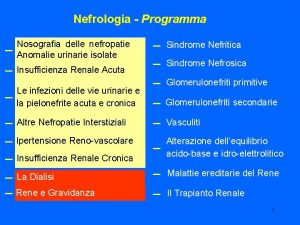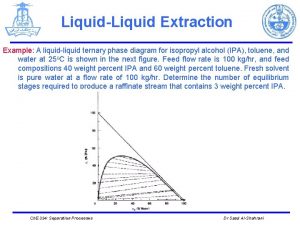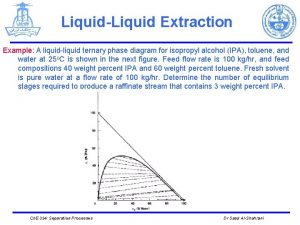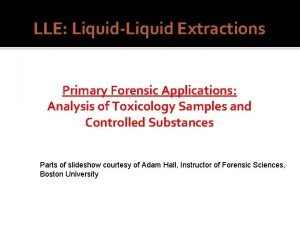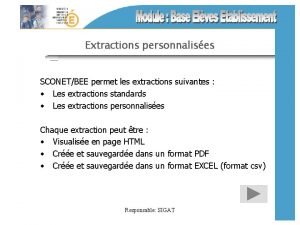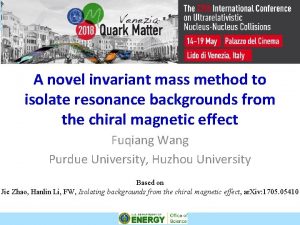LiquidLiquid Extractions as a Novel Method to Isolate


![Calcium Speciation in HCl 100% Concentration 90% 80% 70% 60% 50% [Ca. Cl 2]/Ca. Calcium Speciation in HCl 100% Concentration 90% 80% 70% 60% 50% [Ca. Cl 2]/Ca.](https://slidetodoc.com/presentation_image_h/ad2abdcb278484cc85ae141817bcd890/image-3.jpg)







- Slides: 10

Liquid-Liquid Extractions as a Novel Method to Isolate Neutral Ca Isotope Species Logan Tegler 1, Stephen Romaniello 2, Ariel Anbar 1, 2 NASA Space Grant 2017 Symposium 1. 2.

Motivation Research goal: Separate the neutrally-charged complexes of Ca (Ca. Cl 2) to learn about isotope fractionation at equilibrium Understanding the isotopic fractionation of Ca and other inorganic species is important for: Providing insight about an inorganic element’s isotopic fractionation at equilibrium Creating new geochemical experimental tools Exploring precipitation and absorption processes
![Calcium Speciation in HCl 100 Concentration 90 80 70 60 50 Ca Cl 2Ca Calcium Speciation in HCl 100% Concentration 90% 80% 70% 60% 50% [Ca. Cl 2]/Ca.](https://slidetodoc.com/presentation_image_h/ad2abdcb278484cc85ae141817bcd890/image-3.jpg)
Calcium Speciation in HCl 100% Concentration 90% 80% 70% 60% 50% [Ca. Cl 2]/Ca. T 40% [Ca 2+]/Ca. T [Ca. Cl+]/Ca. T 30% 20% 10% 0% 0 2 4 6 HCl (M) 8 10 12

Experimental Design Goal: physically separate neutral Ca species from charged Ca species using liquid extraction. We hypothesized that neutral Ca species would be preferentially extracted into the nonpolar solvent. Heptane HCl Method of separation 5 m. L of HCl (polar) with Ca. Cl 2 dihydrate and 5 m. L of heptane (nonpolar) are mixed; separate into polar and nonpolar components.

Method Development 2. Insert acid portion from (1) and dilute 1. Mix solutions of heptane and acid 3. Insert heptane from (1) and add 0. 01 M HCL 4. Insert acid from (3). 5. Run (2) and (4) on Q-ICP-MS for Ca concentrations

Results No substantial portion of Ca was extracted into the organic component Results indicated that the heptane and acid portions may not have been totally separated. Heptane may be an unsuitable solvent for this type of extraction Experimental modifications are required

Tests for Separation Performed Experiments Proposed Experiments Acid molarity Longer shaking times Concentration of Ca in Staggered acid molarity solution Number of back extractions Different organic solvent Implementation of a ligand

Conclusions Although separation was unsuccessful, future experiments may achieve desired result Different organic solvents should be tested to see which works best The use of a ligand may be used to encourage the neutrally charged Ca. Cl 2 isotope

Acknowledgments A special thanks to: Dr. Ariel Anbar Dr. Stephen Romaniello Alyssa Sherry ASU NASA Space Grant

Questions?
 Balancing and compensating extractions
Balancing and compensating extractions Transport media for mycobacterium tuberculosis
Transport media for mycobacterium tuberculosis Insulate and isolate
Insulate and isolate Anomalie urinarie isolate
Anomalie urinarie isolate Symposium in education
Symposium in education What is epistolary
What is epistolary Characteristics of victorian fiction
Characteristics of victorian fiction Heart of darkness as a modern novel
Heart of darkness as a modern novel To kill a mockingbird bildungsroman
To kill a mockingbird bildungsroman Victorian novel definition
Victorian novel definition Techniques in victorian poetry
Techniques in victorian poetry



